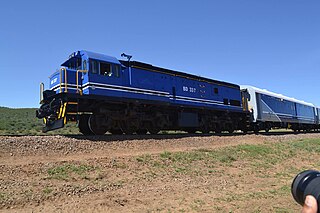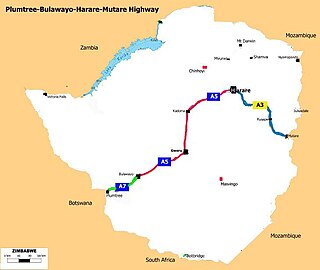
Modes of transport in Mozambique include rail, road, water, and air. There are rail links serving principal cities and connecting the country with Malawi, Zimbabwe and South Africa. There are over 30,000km of roads, but much of the network is unpaved.
This article is about the Transport in Zambia.

The National Railways of Zimbabwe (NRZ), formerly Rhodesia Railways (RR), is a Bulawayo headquartered state-owned enterprise that operates the country's national railway system. It was established in 1893 and governed by an Act of Parliament. It has a commercial-administrative center in Harare and a supply center in Gweru. The Zimbabwean railway system was largely constructed during the 20th century.

Beitbridge is a border town in the province of Matabeleland South, Zimbabwe. The name also refers to the border post and bridge spanning the Limpopo River, which forms the political border between South Africa and Zimbabwe. The border on the South African side of the river is also named Beitbridge.

The Republic of Zimbabwe is broken down into 10 administrative provinces, which are divided into 64 districts and 1,970 wards.

Rail services in Botswana are provided by Botswana Railways in Botswana. Most routes in the country radiate from Gaborone. The railway network consists of 888 km, its gauge is 1,067 mm cape gauge.

The A4 is a highway, also known as the R1 Highway, which runs between Beitbridge and Harare. From Beitbridge it passes through Rutenga, Ngundu, Masvingo, Mvuma, Chivhu before reaching Harare.
The A6 is a highway in Zimbabwe running from the Beitbridge border with South Africa, through Gwanda, to Bulawayo. It is part of the R9 Route, which links Beitbridge with Victoria Falls.
Railway station in Beitbridge include:

The Plumtree-Bulawayo-Harare-Mutare Highway is a cross country international standard highway in Zimbabwe. It connects Mutare with Plumtree via Harare and Bulawayo. It is formed by two routes, namely the R5 Road and the R2 Road.

The R2 Road is an international road in Zimbabwe that runs from Harare, through Bulawayo, to Plumtree border post.
The R3 highway is a primary road in Zimbabwe that runs from the capital city, Harare, to the Chirundu Border Post with Zambia. It is also known as the A1 highway. It is part of both the Beira–Lobito Highway and the Cape to Cairo Road.
The A9 Road is a national highway in Zimbabwe running from Mutare to Mbalabala. The road begins in Mutare and runs south-west through Nyanyadzi, Birchenough Bridge, Masvingo, Mashava, Zvishavane, Filabusi and ends at Mbalabala where it joins the (A6) Bulawayo-Beit Bridge Highway near the 61.5 km peg. The 513 kilometres (319 mi) highway is about a 6 hours 15 minute drive.

Chirundu–Beitbridge Road Corridor is a Trans-African Highway Network Zimbabwean link between South Africa and Zambia. It is part of the North–South Corridor Project and forms the entire Zimbabwean section of the Cape to Cairo Road.
The R6 Highway is a primary road, a trunk road and regional road corridor link road in Zimbabwe.
R7 Highway is a primary, paved, regional road corridor in central Zimbabwe virtue of linking the regional corridors R1 Highways that runs from Harare to Beitbridge via Masvingo, and R2 Highway that runs from Harare to Plumtree via Bulawayo.

The A10 Highway is a primary road that runs from Ngundu in south Masvingo Province to Tanganda through the Mutare-Masvingo Highway in Manicaland Province.

Beira-Bulawayo railway, also called Machipanda railway, Beira-Harare-Bulawayo railway and Beira railway, is a railway that connects the city of Beira, Mozambique, to the city of Bulawayo, in Zimbabwe. It is 850 km long, in a 1067 mm gauge.












